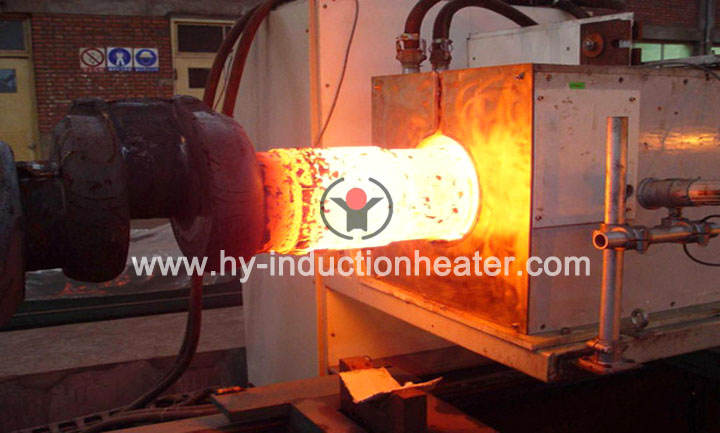IF induction forging, hardening/quenching & annealing
IF induction heat treatment equipment is widely applied in forging, hardening, quenching and annealing field. The power of IF heating furnace can be 100-8000KW, which is suitable for round bar,pipe & tube, billet through heating before forging or rolling, especially for large and long bars.
IF induction forging equipment
IF forging refers to the use of an induction heater to pre-heat metals prior to deformation using a press or hammer. Typically metals are heated to between 1,100 and 1,200 °C (2,010 and 2,190 °F) to increase their malleability and aid flow in the forging die.

Benefits of IF forging equipment
Quality
Precise control provides consistent temperature uniformity and exact repeatability. Forgings have fewer inclusions and improved surface finish because of reduced scale.
Flexibility
Induction heats only the workpiece using only the needed energy to achieve the exact temperature. New solid state power supplies seek the best frequency for the load further improving operating flexibility and efficiency.
Productivity
An integral induction heating system increases productivity because it is easily integrated with in-place processes. An induction heater, not the operator, sets the pace for the production rate. Induction heaters can be started from cold to achieve full production rates within minutes. Heaters are designed for automatic hold cycles during delays and rapid recovery at re-start.
Limited Material in Process
Induction heating requires fewer parts in-process which reduces the chance of rescheduling errors and substantially reduces material inventories.
Reduced Scale & Increased Tooling Life
Induction heating brings the work piece up to temperature in the shortest possible time and in effect reduces the amount of scale which improves the surface finish of the end product and increases the customer’s tooling life.
Yield
Typical scale loss in gas fired furnaces is 3% and from induction 0.5%. Consequently, for each ton of forgings the raw steel purchased is reduced by 2.5%.
IF hardening /quenching & annealing production line

Widely used for the surface hardening/quenching of steel or steel alloys
- Powdered metal components
- Long bars & rod
- Long shaft, axle shaft, drive shaft
- Drill rod, drill pipe, drill collar
- Sucker rod,
- Steel pipe & tube
Properties of IF Hardening/quenching &annealing production line
- Very quick and efficient process with rapid heating
- Allows for localized hardening/quenching & annealing
- Depth of surface layer hardened can be varied to meet customer requirements
- The core of the material remains cold during processing and its original properties are unaffected after induction hardening is complete
- Very little distortion and size change as only a portion of the part is exposed to heating for a short time
- Typically performed on carbon and alloy steels with a carbon content between 0.30% and 1.00% C
- Process is uniform, repeatable and controllable
- High control over quality
- Different methods of induction hardening can be employed such as single shot hardening and traverse/scan hardening
- Multiple parts can be treated in a single cycle with some induction machines
- Can be performed on single pieces to large production volume runs
- Material costs are reduced as process is compatible with lower hardenability, lower cost alloys
- Increases durability and resistance to wear




